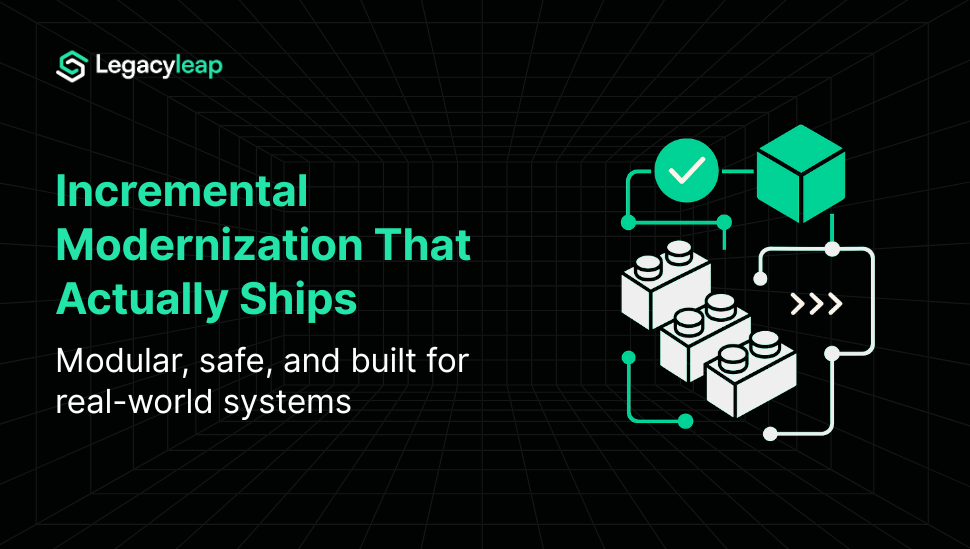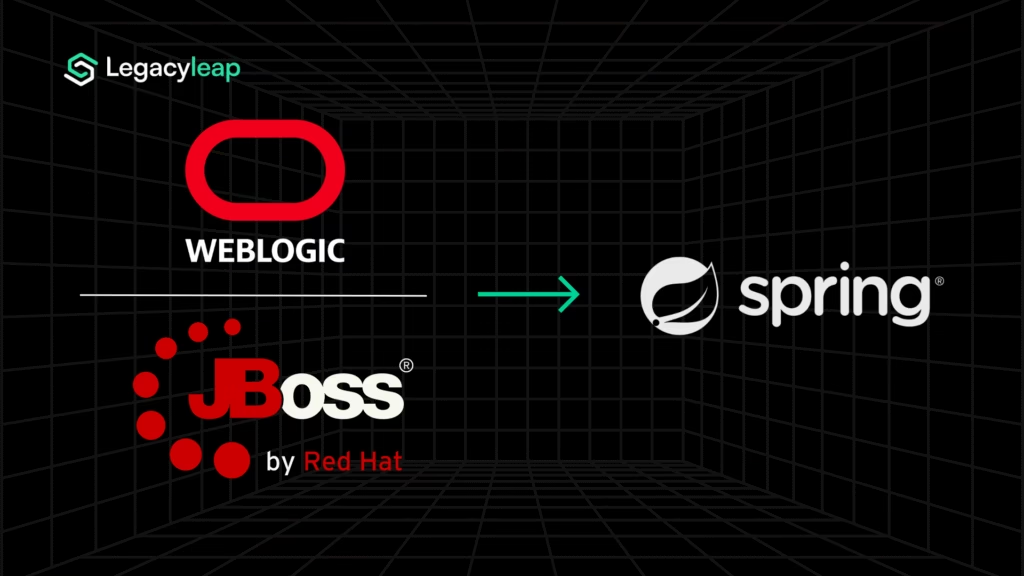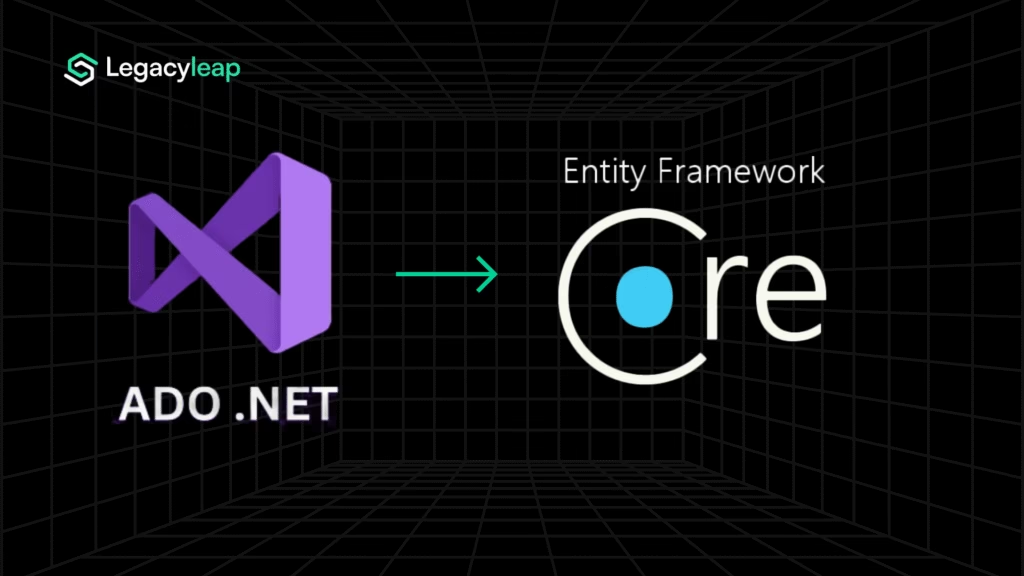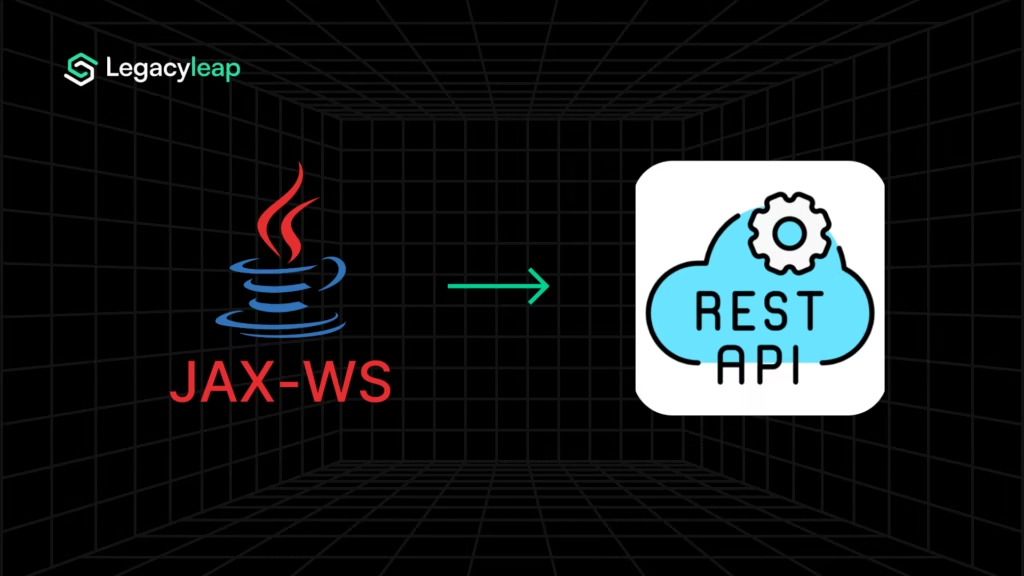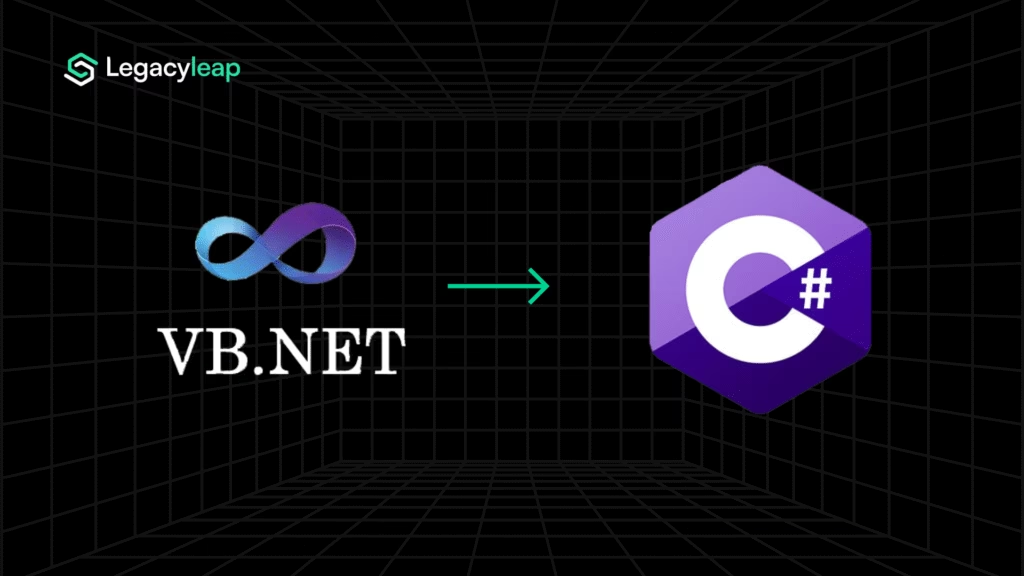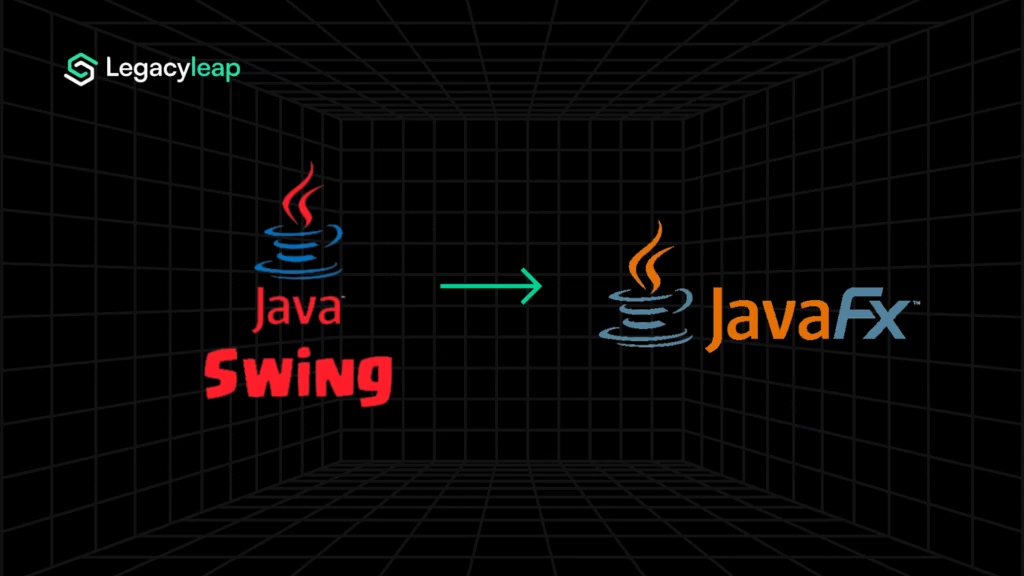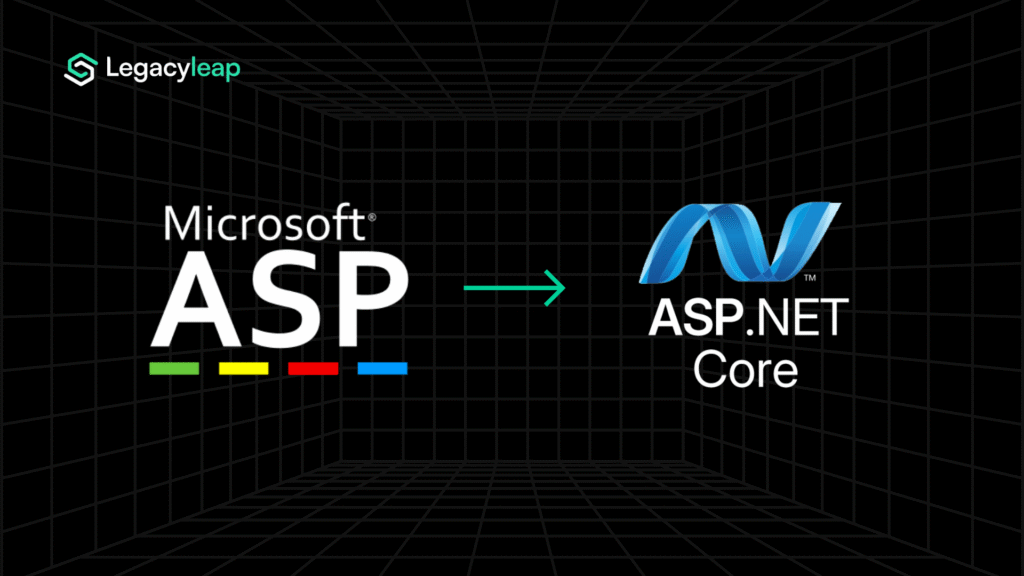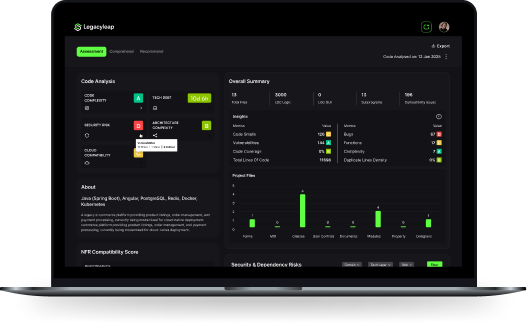Prefer to listen?
This episode of The Legacy2Leverage Show explores the topic in podcast form.
Why Enterprises Can’t Rely on Full Rewrites and Should Choose Incremental Modernization
Most enterprises still dream of a full rewrite. Clean slate. Modern stack. Zero legacy baggage.
But the reality? You rarely get the budget. The risk appetite isn’t there. And the systems you’re trying to replace are still running mission-critical workflows every day.
This is why incremental modernization has become the practical path for enterprise modernization. It balances business continuity with technical evolution.
Done right, it lets you evolve architecture without breaking operations. You modernize while the business keeps running.
At Legacyleap, we’ve built our entire platform around this principle, enabling teams to modernize in place, safely, and continuously. And in this blog, we’re going to show you how it’s done.
What Incremental Modernization Means for Enterprise Modernization
This isn’t about updating one app at a time. That’s a rollout schedule, not a strategy.
Incremental modernization is about identifying modular modernization units: workflows, sub-domains, or bounded contexts that can evolve independently. You’re not rewriting the system but reshaping it from within.
The shift is from application-level thinking to system behavior-level thinking:
- Instead of “modernize the whole billing app,” think: “decouple the invoicing workflow.”
- Instead of “move everything to microservices,” ask: “What domains can own their logic and scale independently?”
This is why modular thinking beats app-by-app replacement:
- It surfaces high-impact units sooner
- It reduces blast radius
- It creates the flywheel for repeatable modernization, not isolated migrations
The goal isn’t to ship a new system. It’s to build a system that can keep changing safely, continuously, and without hitting pause on the business. This modular approach to enterprise modernization ensures that each cycle of incremental modernization reduces risk, accelerates ROI, and builds long-term adaptability.
How Incremental Modernization Enables Change Without System Shutdown
You don’t need to touch everything at once. And you definitely don’t need to start with the hardest part of the system.
The key to incremental modernization is sequencing — identifying areas where you can introduce change without disrupting core workflows.
Here’s how the smartest teams approach it:
- Start with “read” before “write”. Reporting, search, and analytics are great first candidates. They touch production data but don’t change it, making them safer to replatform or rebuild as services.
- Modernize around high-change zones. Domains like pricing, promotions, or customer-facing integrations change frequently. That volatility is a signal: decoupling here pays off fast.
- Look for modernization accelerants. These are parts of the system that:
- Have clear boundaries
- Are lightly coupled to other components
- Deliver value even when modernized in isolation
These accelerants allow enterprises to adopt a modernization without downtime strategy, showing how incremental modernization creates a measurable impact quickly.
This approach isn’t just technically safer, it’s proven to drive real business results. For instance, according to EY, banks that adopt core modernization strategies, including incremental approaches, have seen 20–40% cost reductions, driven by operational efficiencies and improved customer experience.
In other words, you don’t need a complete rewrite to generate returns. You just need to start in the right place.
Legacyleap’s Gen AI agents help identify these low-resistance entry points by analyzing:
- Code coupling
- Usage frequency
- Change history
- Domain-level volatility
Why this matters: Incremental doesn’t mean random. Sequence matters. Pick the right starting points, and you build momentum, not just modern code.
The Top 5 Myths Holding Back Enterprise Incremental Modernization
The blockers to modernization aren’t always technical. Often, they’re assumptions, widely held, rarely questioned, and deeply costly.
Let’s break them down.
Myth 1: “You can’t modernize without full domain understanding.”
You’ll never have perfect clarity. The goal is to modernize around what’s already well-understood, not to pause until every edge case is mapped.
What helps: Gen AI-assisted business logic extraction and usage mapping. Start with what’s stable. Learn as you go.
Myth 2: “We need to fix all tech debt first.”
No, you don’t. Fix what’s in the path of value delivery. Some debt can be isolated. Some can be wrapped. All of it doesn’t need to block progress.
What helps: Component-level risk scoring to know what’s worth touching and what’s not.
Also read: How to Identify and Address Technical Debt in Legacy Applications.
Myth 3: “We have to finish cloud migration first.”
Cloud isn’t the finish line. It’s just another shift in context. You can modernize systems on-prem, hybrid, or mid-move. The two can happen in parallel.
In reality, incremental modernization can run in parallel with cloud adoption, ensuring that enterprise modernization progresses without waiting for a complete migration.
What helps: Modernization strategies that work across environments, not just post-cloud.
Myth 4: “Microservices are the only valid end state.”
They’re a tool, not a goal. The right target might be modular monoliths, domain-aligned services, or just cleaner boundaries within a single system.
What helps: Architecture guidance aligned to business structure, not tech trends.
Also read: Monolith vs Microservices Architecture: When, Why, and How.
Myth 5: “We’ll get to it after the next product release.”
You won’t. Because the next release has another one behind it. Modernization doesn’t compete with delivery. It gets embedded into it.
What helps: Feedback loops inside your delivery pipelines, where modernization tasks ride along with product cycles.
At Legacyleap, we’ve designed our platform to systematically dismantle these myths through real-world signals:
- Automated dependency maps
- Gen AI-led logic surfacing
- Risk heatmaps at the component level
- Incremental rollout support inside active delivery workflows
Most stalled efforts didn’t fail on execution. They failed on assumptions. Kill the myth, and the path forward gets a lot clearer.
Incremental Modernization vs Full Rewrite: Enterprise Trade-offs
| Criteria | Incremental Modernization | Full Rewrite |
| Approach | Modernizes one module or service at a time, driven by business priorities | Rebuilds the entire system from scratch in a single initiative |
| Risk Management | Controlled risk with fallback to legacy modules if needed | High risk due to all-or-nothing switchover |
| Time to Value | Delivers value from the first modernized component | Long ramp-up; value realized only post-launch |
| System Downtime | Zero downtime with legacy and modern systems running in parallel | Likely downtime or service degradation during cutover |
| Technical Debt Handling | Prioritizes and addresses technical debt incrementally | Attempts to eliminate all tech debt at once, often impractical |
| Change Adaptability | Easily accommodates mid-course corrections or reprioritization | Difficult to pivot once rewrite path is defined |
| Cost Efficiency | Costs are spread out, allowing phased budgeting and ROI tracking | High upfront investment with delayed ROI |
| Gen AI Leverage | Enables AI-driven discovery, testing, and orchestration at each step | Requires upfront documentation and high planning accuracy for AI to be effective |
How the Incremental Modernization Flywheel Builds Continuous Momentum
Incremental modernization works because it builds momentum. Each cycle delivers value, reinforces confidence, and creates the blueprint for what comes next.
Here’s what the loop looks like in practice:
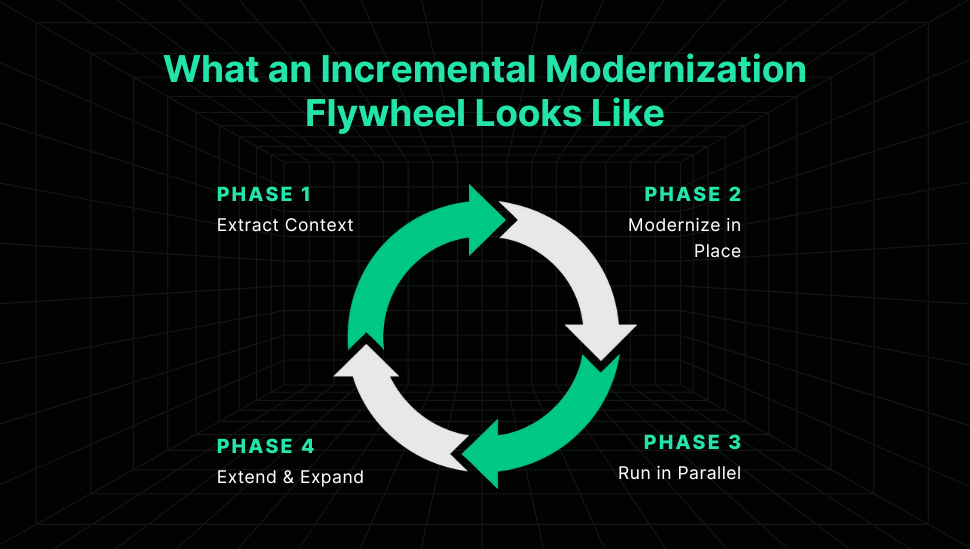
1. Extract Context
Start with visibility. Not just code, but how that code is used.
- Analyze source code, dependency graphs, and historical change logs
- Map business logic to real workflows, not just file structures
- Gather input from delivery teams who know what breaks and why
This phase sets the foundation. You’re not just looking for what’s outdated but for where the risk is low and the upside is high.
2. Modernize in Place
Avoid the temptation to replace. Instead, reshape the system from within.
- Wrap legacy modules in service interfaces
- Carve out subdomains (e.g. pricing, auth, reporting)
- Refactor high-friction components while preserving system contracts
The goal isn’t perfection but to progress with minimal disruption. Done right, even a small rewrite creates scaffolding for future change.
3. Run in Parallel
Deploy the modernized unit alongside legacy components, not instead of them.
- Mirror functionality to test output and behavior
- Use feature toggles, proxies, or shadow traffic to validate real usage
- Monitor performance, error rates, and change impact in isolation
This phase builds confidence without consequence. If something fails, the legacy fallback is still live.
4. Extend the Model
Once the first success lands, don’t reinvent. Scale what worked.
- Reuse deployment pipelines, logging standards, and service templates
- Apply learnings to the next domain, with fewer unknowns
- Allow architecture to emerge through validated patterns, not theoretical blueprints
Each cycle makes the next one easier, faster, and safer. That’s how modernization becomes part of delivery, not an initiative outside of it.
This incremental modernization flywheel lies at the heart of scalable enterprise modernization, enabling organizations to sustain transformation continuously.
Checklist: How to Start Incremental Modernization Safely
- Identify modernization triggers
Flag legacy bottlenecks (unsupported tech, compliance risk, or business-critical slowdowns) as starting points. - Map interdependencies
Use Gen AI to trace how services, data, and APIs are linked, preventing unintended breakages. - Select low-risk, high-value domains
Start with non-customer-facing or well-understood areas to gain confidence and show early ROI. - Define modular rollout boundaries
Break down modernization scope into small, self-contained chunks with clear start/exit criteria. - Run legacy and modern in parallel
Maintain legacy availability while validating modern components in production environments. - Track impact per cycle
Measure delivery time, performance gain, and end-user outcomes for every increment. - Document reusables for the next round
Capture patterns, automation logic, and test cases to reduce time in subsequent cycles.
A Real-World Case Study of Incremental Modernization in Enterprises
“A complex system that works is invariably found to have evolved from a simple system that worked.”
— Gall’s Law
When our CTO led digital transformation for a major UK retailer, the team deliberately avoided a full rewrite. Instead, they carved out domains like Pricing and Promotions, built modern microservices, and maintained safe communication with their legacy Oracle system via an anti-corruption layer.
Each change delivered business value quickly. Nothing broke. Over time, what began as incremental fixes became a system capable of rapid innovation.
“This methodical evolution (NOT revolution) approach paid dividends. Each incremental change delivered tangible business value without disrupting operations. The system grew more flexible and resilient over time, ultimately enabling innovation at a pace that would have been impossible with our monolithic architecture.”
— Rajat Singhal, CTO
Modernization shouldn’t be a leap of faith. Incremental modernization isn’t slow or small. Done right, it becomes a loop that compounds progress without halting delivery.
Why Enterprises Should Start Incremental Modernization Now
The biggest myth in modernization? That there will be a “right time” to do it.
But legacy systems don’t stop aging. Delivery timelines don’t slow down. And business expectations don’t wait for clean slates.
The smartest teams don’t try to predict the future. They build systems that are ready for it, one modular, risk-adjusted change at a time. That’s why IT and business leaders increasingly see incremental modernization as the fastest, safest path to enterprise modernization in 2025 and beyond.
Incremental modernization isn’t about moving slowly. It’s about moving intentionally, with the flexibility to adapt, the structure to deliver, and now, the tools to accelerate.
That’s what Gen AI makes possible. And that’s why we built Legacyleap:
To help enterprises modernize with precision, inside real-world delivery environments, without rewriting the entire past to build the future.
Want to see what that looks like with your own systems? Our $0 modernization assessment can show you exactly where to begin.
FAQs
Incremental modernization delivers small wins quickly, like replacing a legacy UI with a responsive one or migrating a single service to a cloud-native equivalent. These visible improvements demonstrate momentum, prove value early, and build credibility with internal stakeholders, especially when paired with measurable outcomes like improved performance or reduced latency.
It’s not ideal when systems are tightly coupled, undocumented, or riddled with unfixable tech debt. In such cases, making partial changes can introduce more instability than benefit. A full rewrite may be more effective if the legacy architecture lacks clear boundaries or cannot support modular execution without major disruption.
Common pitfalls include unclear sequencing of changes, lack of a flywheel strategy, and failing to measure the impact of each cycle. Others include siloed ownership, where business and tech teams don’t stay aligned, and prematurely decommissioning legacy components before validation is complete.
Incremental modernization can begin with rehosting legacy apps on modern infrastructure, then move to refactoring core services, and eventually rearchitecting parts of the system into microservices or event-driven modules. These phases can be executed in parallel or sequentially based on system criticality and risk tolerance.
Coexistence can introduce complexity in data sync, authentication, and user experience. For instance, if state is not shared between the old and new systems, users may face inconsistent behavior. There’s also a risk of regression if integration boundaries aren’t well-defined or test coverage is insufficient across systems.


